The second legs of the UEFA Champions League semi-final round began this week with Manchester City hosting Paris Saint-Germain at the Etihad Stadium on Tuesday night. Less than a week ago, Pep Guardiola’s side came back from behind in France after a slow start to pick up a 2-1 win on aggregate that also gave them the cushion of two away goals. Thus, PSG came into this game knowing that they needed to score at least twice to have any chance of going through to a consecutive final, which would always be difficult against this City side, especially at the Etihad.
Manchester City managed to control the game well and sealed a first-ever Champions League final for the club, and this tactical analysis will look at the tactics from both sides, as well as the difference-makers.
Lineups
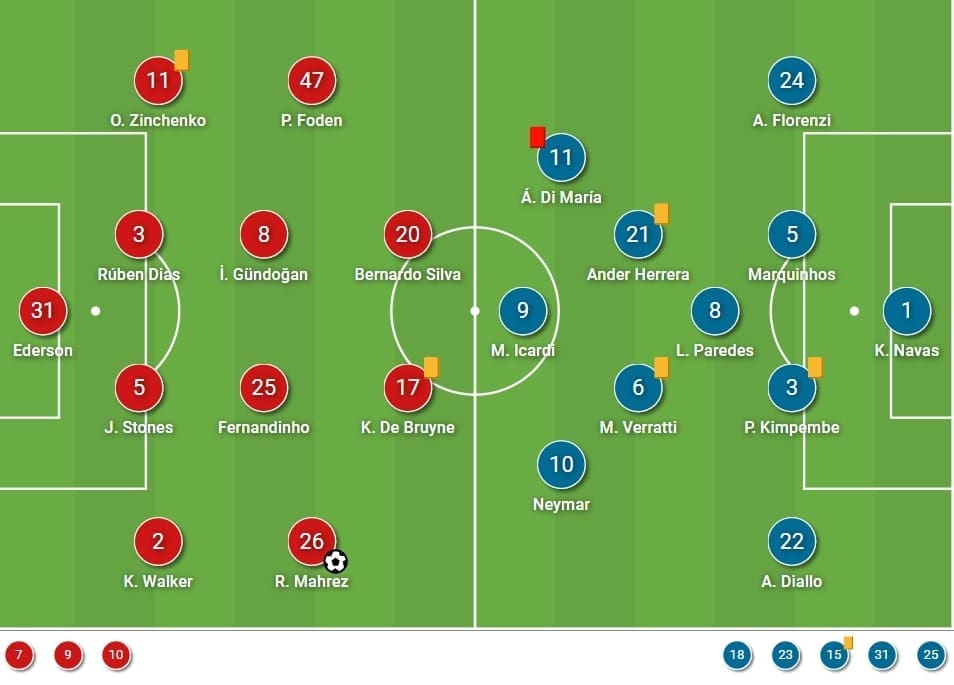
Pep Guardiola rested the majority of his players at the weekend against Crystal Palace, and so there were two changes from the XI that featured in the first leg – Oleksandr Zinchenko replaced João Cancelo at left-back, while Fernandinho, on his 36th birthday took Rodri’s spot in midfield.
The big news for PSG fans was that Kylian Mbappé was not fit to play in this match, having missed the game against Lens at the weekend as well. Mauricio Pochettino brought in Mauro Icardi as his replacement, while Ander Herrera came into the XI in place of Idrissa Gueye, who was sent off in the first leg. Finally, Mitchell Bakker was dropped as Abdou Diallo started at left-back.
PSG did not pose a scoring threat
PSG had 14 shots without registering a single one on target, which shows how City were able to keep them at arm’s length. Despite needing a goal to turn things around, their offensive performance was a bit disappointing. This is not to take any credit away from City – the home side defended well with plans that worked out on the night and kept the Parisians at bay.
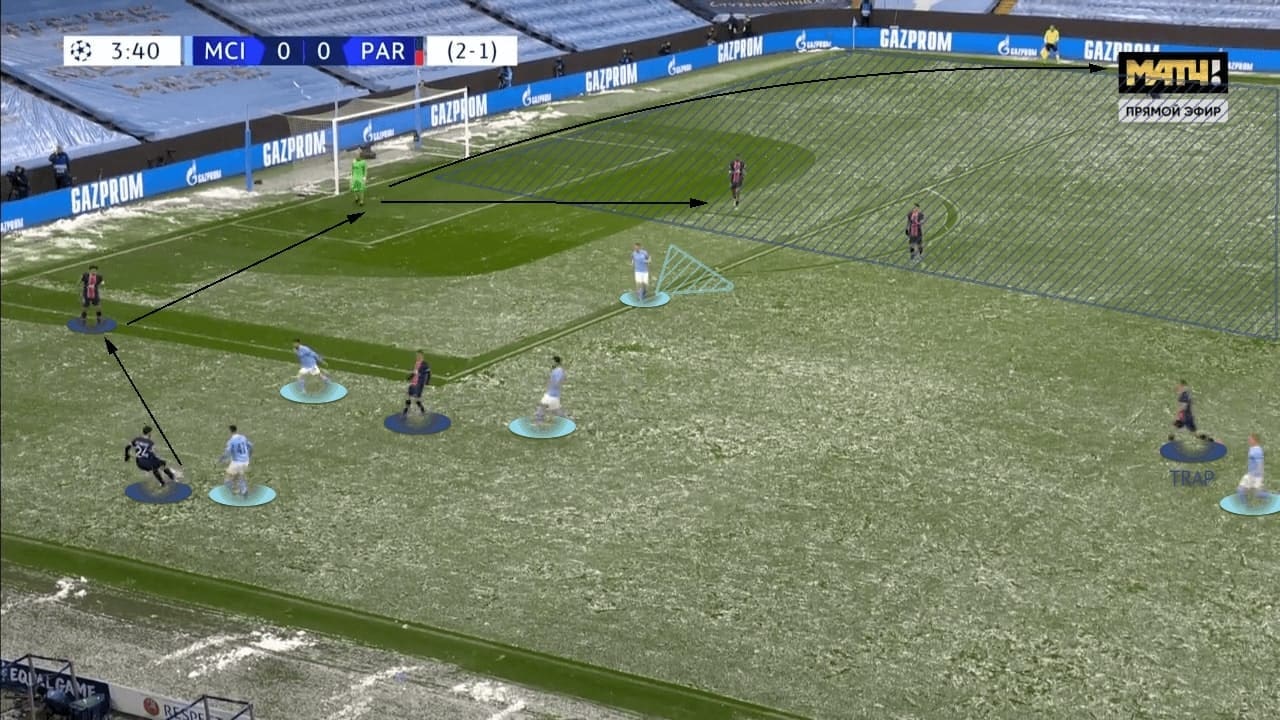
City’s pressing strategy of utilising pressing traps on the PSG midfield had not worked in the first leg, which had forced Guardiola to change tack around 30 minutes into that game. He continued with the latter approach from the start here, as the home side pressed one vertical half to force the ball to the other side. This image shows how City have committed players high up the pitch to the press on the ball side – they have a 5v4 advantage here, with the players also using their body shadow to cut out switches to the opposite flank. City were also aggressive in pressing PSG players who would attempt to drop deep and offer a vertical passing option, as seen in Zinchenko’s positioning here on the right of the image.
However, PSG had also learnt from their mistakes in the first leg. The players on the ball-side tried to use Keylor Navas in goal to facilitate switches to the opposite flank, where they could attempt to utilise their numerical superiority, rather than getting caught in possession in their own half. This example shows how Marquinhos elected to pass back to Navas here, rather than going for a vertical pass, which is what he was doing in the first half. This allowed them to evade pressure and play the ball out into space eventually.
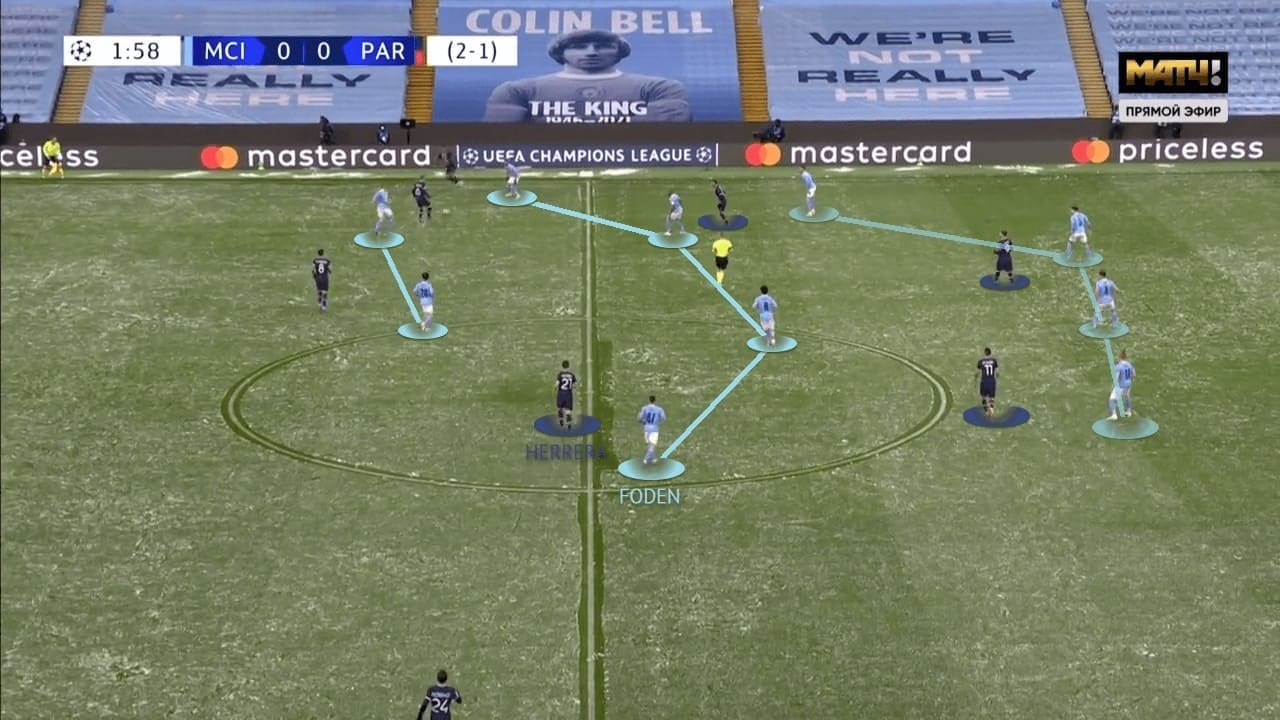
However, given that they had the lead on aggregate, City were happy to sit back in a deeper block after the initial press was broken in this match, only looking to press aggressively when PSG attempted to move into the final third. We can see this through City’s PPDA for this match, which was at 18.14, compared to 10 in the first leg.
The above image shows both sides’ setup when PSG were in their build-up phase. City defended in a 4-4-2 block with Bernardo Silva and De Bruyne as the first defensive line. The duo pressed from inside to outside, inviting PSG to play out to the flanks where spaces were limited. Also, with the full-backs aggressively stepping up early, City had the numbers to defend these areas well and reduce space, in tandem with the front duo’s pressing efforts.
PSG’s tactics were to try and release Neymar as the free player, with Ángel Di María also roaming to try and find space. Width was supplied by the full-backs, and with a pair of narrow wingers, PSG had the numerical advantage over City, who only had the two central midfielders in their 4-4-2 manning this area. To maintain compactness and avoid this situation, City’s wide players tucked in to provide support and cut out space and passing lanes, as we can see here with Foden when the ball is on the opposite side.
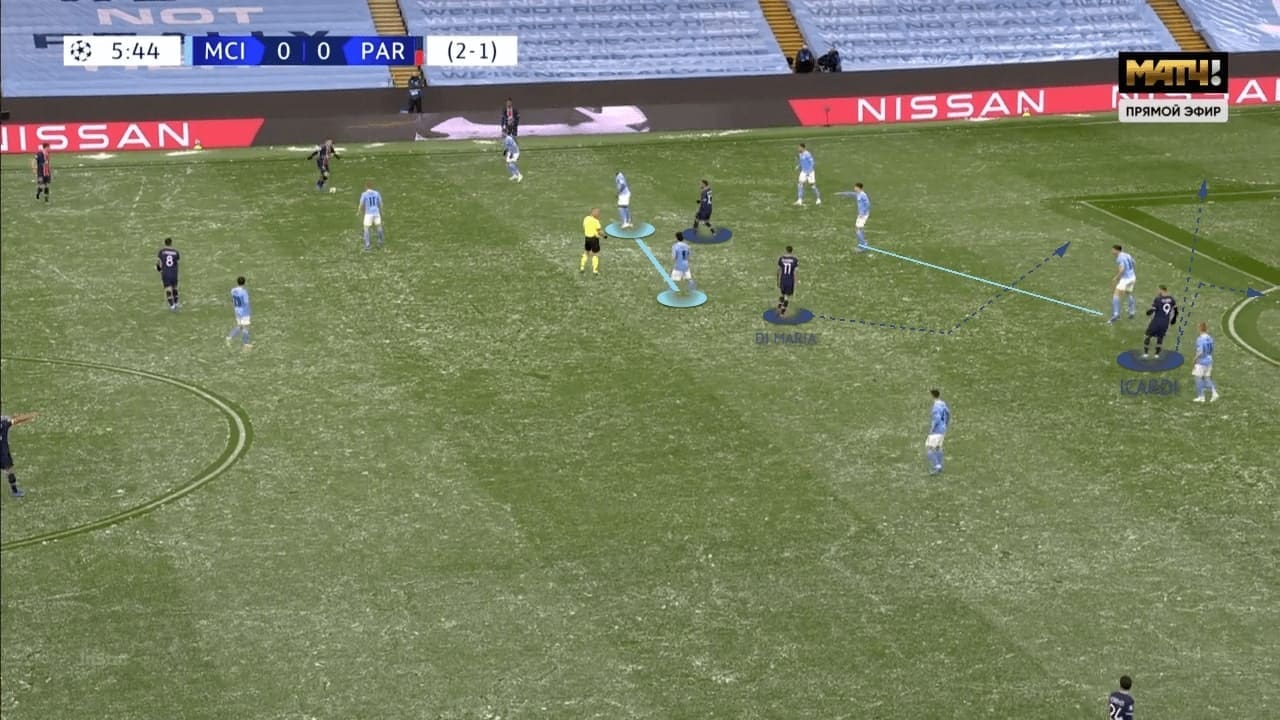
In this deeper block, the City midfielders also stayed deeper, and closer to their defensive line. This helped reduce space between the lines for Neymar and Di Maria to receive possession, and we can see this in the above image, where Fernandinho and Gündoğan have dropped deep.
However, City’s defence was far from perfect. Gaps within the back four were opened up on some occasions but PSG failed to exploit those channels.
For example, there is a huge gap between the City centre-backs here, since John Stones has moved slightly wider. Both Di María and Icardi were positioned well, and had running routes in behind to attack those spaces. However, PSG did not seize this opportunity, and this was the case throughout this match.
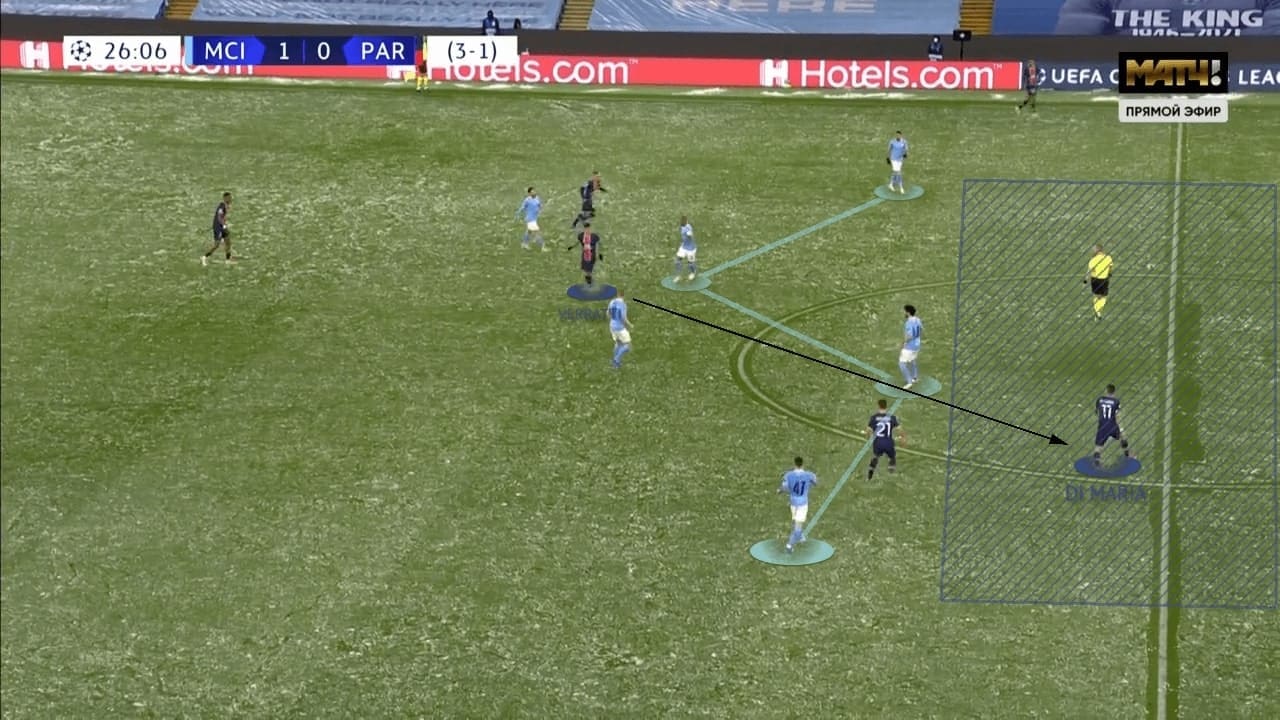
PSG’s ability to find spaces behind the City midfielders was much better compared to the clash in Paris. Tactically, this explained Pochettino’s decision to move to a 4-3-3 formation, which was also flexible enough to shift to a 4-2-1-3 or 4-1-2-3, creating different layers to offer progressive options for the players.
There was also a simple numerical overload available through this setup against City’s midfield duo. Even when Foden stayed narrow, PSG could still find space behind the City midfield. They tried to use a double-pivot to draw Fernandinho or Gündoğan out of position – in this example, the 36-year-old moved up the pitch to press but was unable to cut out the passing angle. As a result, the narrow winger – Di María, became the fourth man and the free player to receive between the lines.
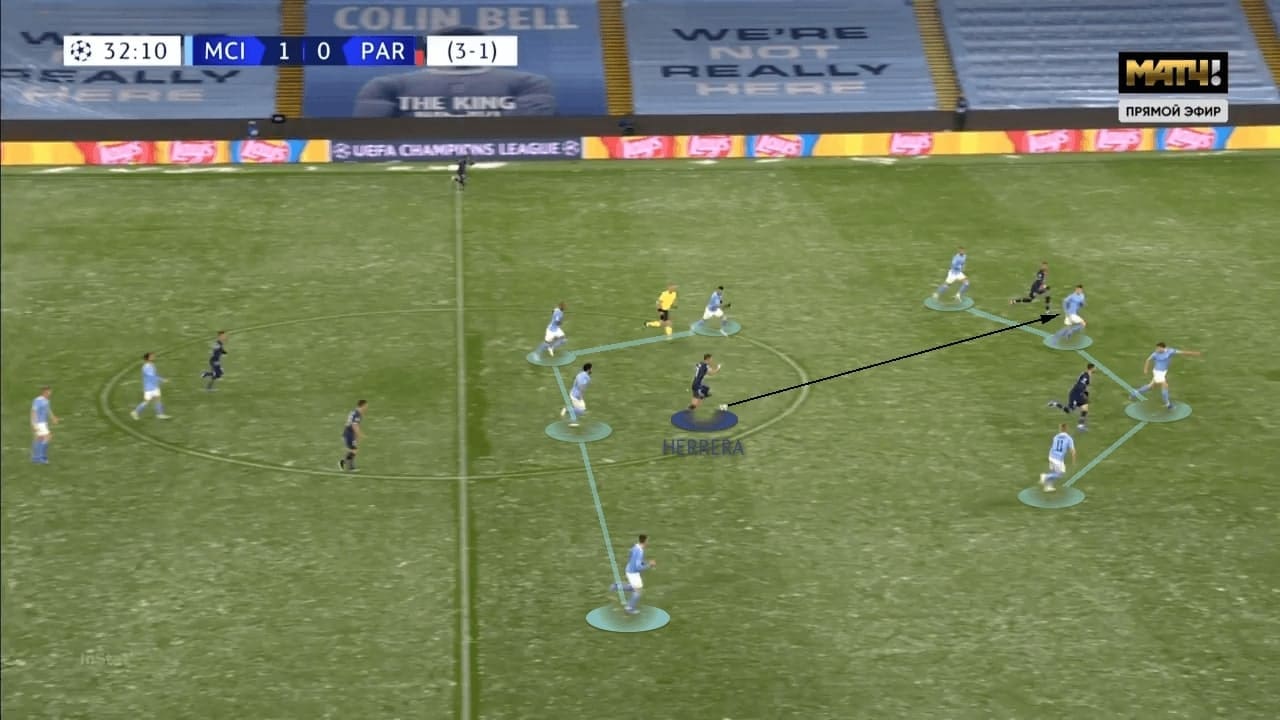
Apart from Di María, Herrera was another option to receive between the lines too. Paredes and Verratti were often able to find the free player between the lines from their relatively deeper positions, creating situations where PSG were able to run at the City backline in space.
However, the home defence reacted extremely well when the midfield was bypassed. They did not panic or make rash challenges that could result in space opening up behind them. Instead, the defenders reacted calmly, retreating and delaying such attacks, which bought time for the midfield to come back and help out as well. This was one of the most important improvements in City’s defending compared to their games in previous Champions League knockout rounds.
In this example, Herrera had the ball behind Gündoğan and Fernandinho, and Icardi and Neymar made split runs in front of him to try and increase the distance between the City defenders. Neymar is the only viable option here, as Herrera is a right-footed player. However, finding this pass was extremely difficult, as the City back four stayed narrow to minimize gaps.
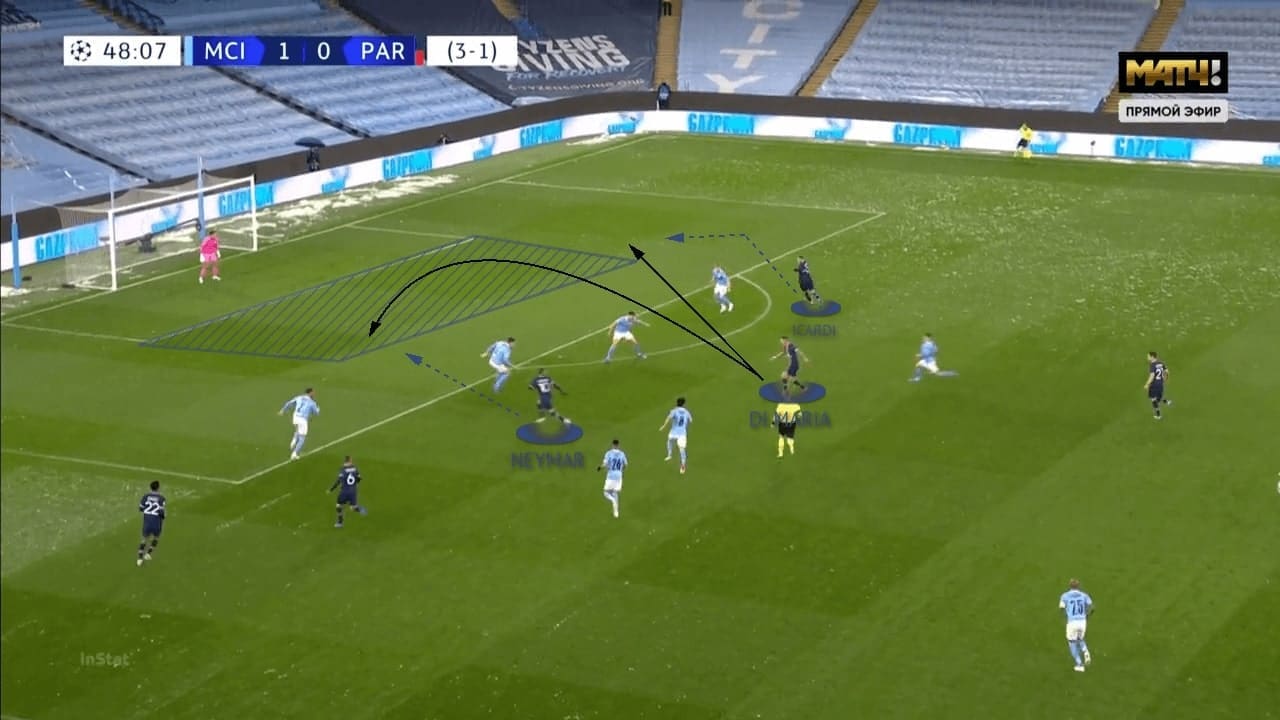
The fact that PSG got 14 shots without a single one on target suggests that they were unable to find the last, telling pass to set themselves up in good positions. While City’s excellent defending was a big reason for this, the PSG attackers also did not help themselves with some poor decision-making in the final third.
Here, Di Maria has the ball outside the penalty area, with Icardi and Neymar making promising runs either side of him. However, the Argentinian chose to shoot, with Ruben Dias able to block easily. This sort of decision-making let PSG down throughout this match.
Gündoğan’s cleverness is the key
City were also quite good in an attacking sense, being able to get past the PSG press on multiple occasions to set up promising situations. Ilkay Gündoğan’s performance was a big factor behind this, with the German international playing a crucial yet understated role in City’s attacking play.
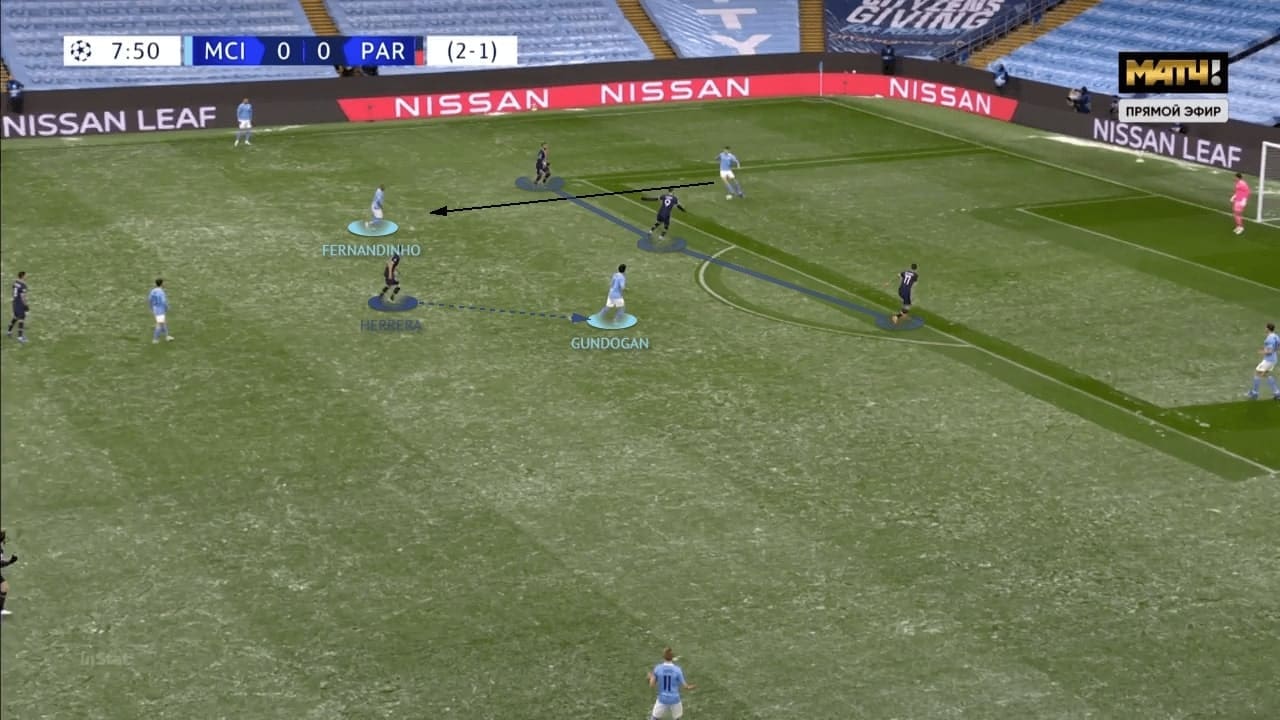
PSG generally pressed in a 4-2-1-3 with Herrera supporting the front three from midfield. Pochettino wanted the strikers to pay more attention to Ederson, so the former Manchester United player was asked to drop onto Fernandinho. However, Gündoğan and Fernandinho were able to get past this and give City a good build-up structure. These two players would stay in the same horizontal zone, creating a 2v1 overload on Herrera, while Silva and De Bruyne changed their positions to drag Verratti and Paredes out and create space for each other higher up the pitch.
This was why City were able to play out from the back quite comfortably at times, including on this occasion. When Herrera went for Gündoğan in the press, Stones saw that Fernandinho was the free player, and the PSG press was bypassed.
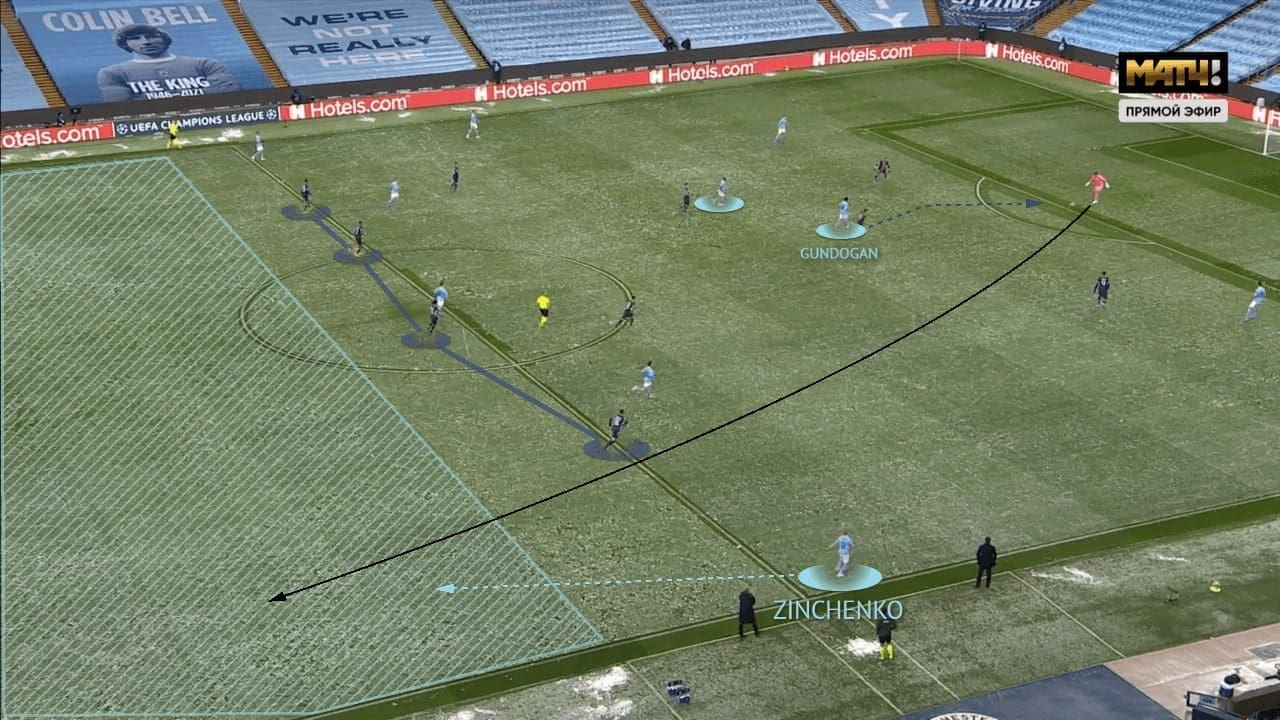
Even though PSG were trying to limit Ederson’s time on the ball, the Brazilian was able to have a direct influence on the match through his pass to Zinchenko for the first goal. While his passing ability must be lauded, there was another detail here that shows Gündoğan’s influence.
Notice Gündoğan’s positioning before the kick. He formed a double-pivot with Fernandinho in midfield again, creating a 3-2 shape at the centre. Gündoğan’s positioning forced Di María to try and close him down first and then move on to Ederson. This changed the direction of his pressure, and meant that he was pressing Ederson on his right side, rather than his favoured left foot, which allowed the goalkeeper to make this pass fairly easily.
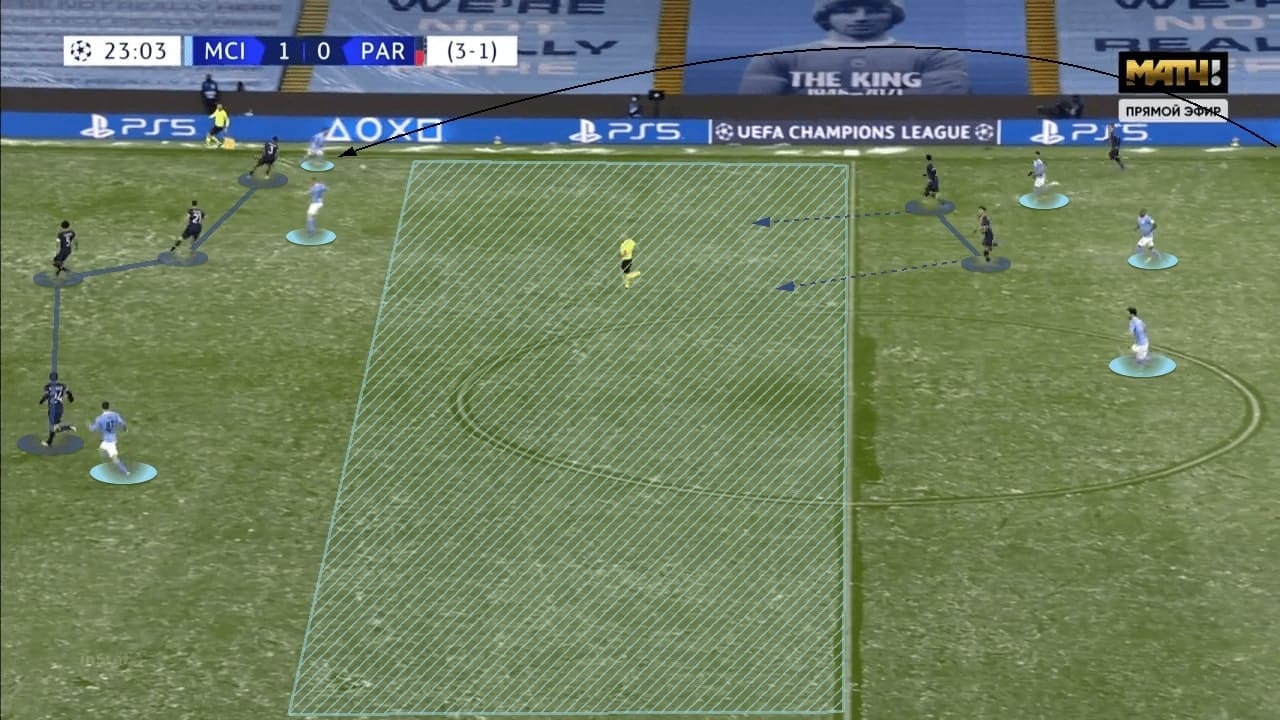
City were also slightly more direct in this game. With the principle of players holding offensive height, they could always use a long ball to bypass the PSG press.
In this example, Walker played long instead of risking short passes in the build-up phase. City already had three players staying high which pinned the PSG backline, and helped create the highlighted blue space in midfield, where the recovering PSG midfielders would have huge areas to cover, and City would be able to pass the ball calmly and slow down the tempo of the game when needed as a result.
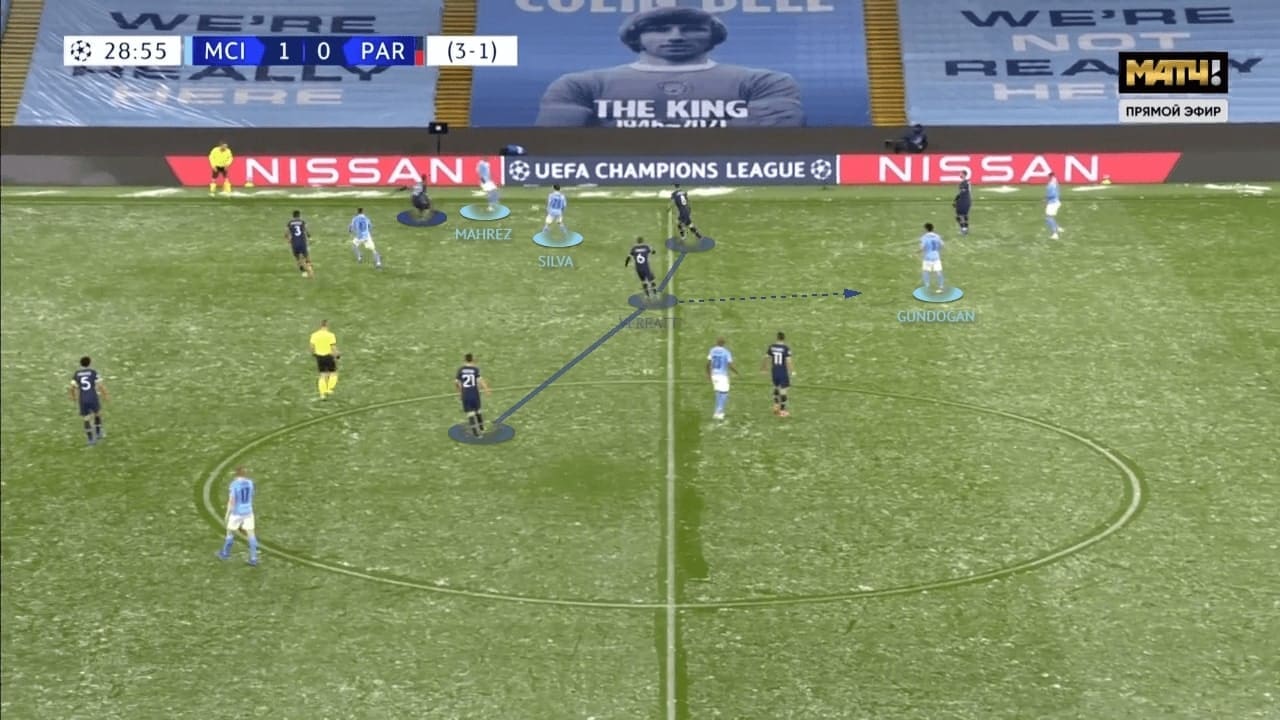
The away side also struggled to deal with Mahrez, as evidenced by his brace. The Algerian has been in excellent form for a few months now, and continued showing his importance to this City side over both legs. Diallo, who was ostensibly selected specifically to handle Mahrez, was poor on the night. The 25-year-old was often too slow to react and step up to Mahrez, which led to him being caught off-balance and late in making a tackle. We can see this here, where Diallo’s late reaction meant that Mahrez was able to receive and turn with the ball on his favoured left foot before the Frenchman was close enough to challenge.
This is also yet another instance of Gündoğan’s intelligence. The German’s positioning draws Verratti’s attention here, which leaves Bernardo Silva free between the lines, and City are thus able to work a third-man combination quite easily.
Final remarks
PSG were disappointing both tactically and mentally across both legs. While Pochettino struggled to find tactical solutions to the problems being posed by City, the Parisians also saw a player get sent off in both legs for silly challenges, and the ending stages of both matches saw multiple PSG players lash out in frustration – it would not have been surprising to see more red cards being shown, and this is another sign that this PSG side is yet to reach emotional maturity. Pochettino has only been in place for a few months, and with the Argentinian making emotional maturity the bedrock of his managerial approach, we should be able to see signs of this next season once he has had more time to get his ideas and methods across to this side.
This analysis has shown how City were clearly the better side on the night, and this was true across both legs. Guardiola has tweaked his side’s approach for them to be more pragmatic in certain situations, while players like Gündoğan and Mahrez have stepped up to become vital cogs in this side. City have now made it to their first-ever Champions League final to satisfy at least one burning ambition of the club’s ownership, and an all-English clash against Chelsea now awaits in Istanbul at the end of this month.





Comments